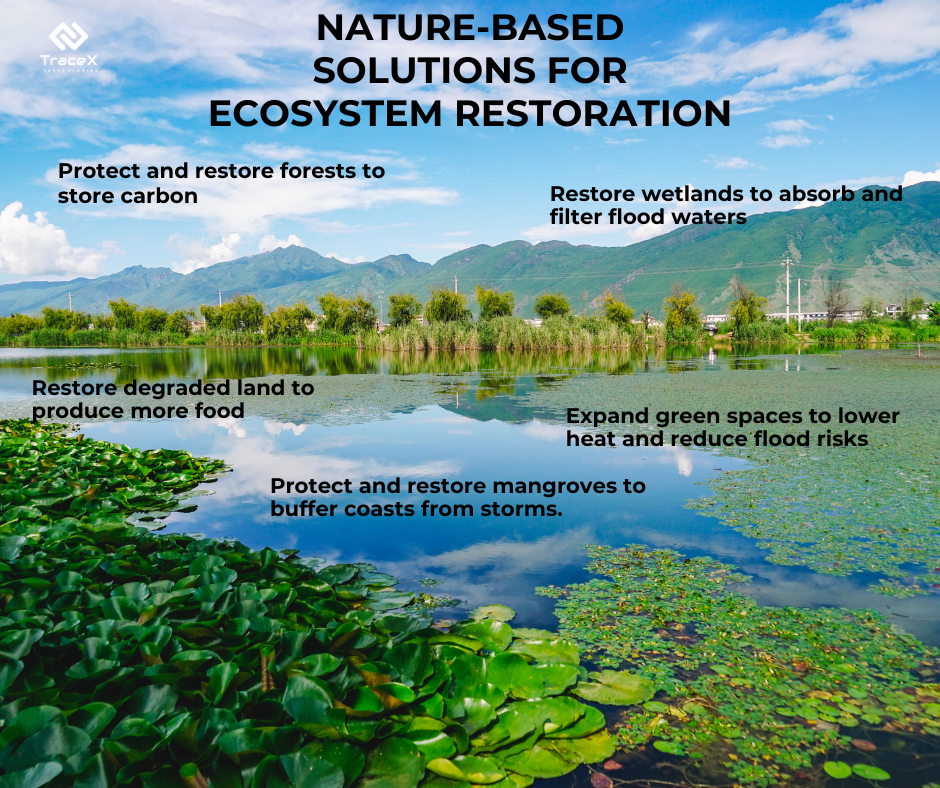Contact: +91 99725 24322 |
Menu
Menu
Quick summary: Discover the essential strategies for successful ecosystem restoration with our blog on the 5 best practices. Explore innovative techniques, technology-driven approaches, and community engagement methods to foster sustainable and impactful restoration initiatives.

Ecosystem restoration stands at the forefront of global environmental efforts, recognizing the critical need to revive and sustain the health of our planet’s diverse ecosystems. As we confront the challenges of climate change, biodiversity loss, and environmental degradation, the call for action on ecosystem restoration has never been more urgent.
Ecosystem restoration is the process of assisting the recovery of an ecosystem that has been degraded, damaged, or destroyed. It is a complex and challenging task, but it is also essential for the health of our planet.
Restoration is essential for keeping global temperature rise below 2°C, ensuring food security for a growing population and slowing the rate of species extinctions.
This blog explores the intricate art of ecosystem restoration, unveiling five best practices that serve as guiding beacons in the journey towards revitalizing our natural habitats. Recognizing the significance of adopting these best practices for effective and sustainable outcomes, we’ll delve into the nuanced processes of understanding ecosystems, thorough assessments, strategic planning, implementation, ongoing management, and monitoring and evaluation.
The adoption of best practices in ecosystem restoration is not merely a technicality but a fundamental driver for achieving lasting and positive outcomes. Best practices provide a roadmap, ensuring that restoration efforts are not only effective in the short term but also sustainable over the long haul. They contribute to the overall success of restoration projects by fostering transparency, accountability, and community engagement, laying the groundwork for a harmonious coexistence between nature and human activities.
To embark on a successful journey of ecosystem restoration, a deep understanding of the ecosystem in question is crucial. Ecosystems are intricate webs of interconnected elements, and a thorough assessment is the cornerstone for effective restoration. This involves comprehending the biodiversity, hydrology, soil composition, and the historical context of the ecosystem. Such assessments guide restoration practitioners in making informed decisions tailored to the unique characteristics and needs of the environment.
Understanding the importance of thorough ecosystem assessments extends beyond immediate project needs. It facilitates the identification of ecosystem services, the intrinsic values of biodiversity, and potential risks or challenges that may arise during the restoration process. Armed with this knowledge, restoration practitioners can develop targeted and context-specific strategies, optimizing the chances of success.
A. Developing a Strategic Restoration Plan
At the heart of successful ecosystem restoration lies a well-crafted strategic plan. This plan serves as a blueprint, outlining the objectives, methodologies, and timelines for the restoration project. It takes into account the findings from ecosystem assessments, aligning restoration goals with the unique characteristics of the environment.
A strategic restoration plan also involves setting realistic targets for biodiversity enhancement, soil health improvement, and water quality restoration. It considers the potential impacts of climate change and aims to enhance the ecosystem’s resilience to future challenges.
B. Incorporating Community Engagement and Feedback
The effectiveness of any restoration project is intricately tied to the support and involvement of local communities. Incorporating community engagement into the planning phase ensures that restoration efforts align with the needs and aspirations of the people who live in and around the ecosystem.
Engaging communities goes beyond merely informing them of the project; it involves active participation in decision-making processes. Local knowledge and traditional practices are valuable assets that can significantly contribute to the success of restoration initiatives. Moreover, fostering a sense of ownership among communities cultivates long-term commitment and stewardship towards the restored ecosystem.
C. Designing Restoration Projects with Long-Term Sustainability in Mind
Sustainability should be at the forefront of restoration projects. Designing initiatives with long-term sustainability in mind involves selecting native species, promoting natural regeneration processes, and integrating measures that enhance ecosystem resilience.
Consideration should also be given to the potential future impacts of human activities and climate change. By designing restoration projects that are adaptive and resilient, the restored ecosystem can better withstand external pressures and continue to thrive in the face of evolving challenges.
With a solid plan in place, the implementation phase transforms aspirations into tangible actions. This involves the actual physical restoration activities, such as tree planting, soil stabilization, or the removal of invasive species.
During implementation, it is crucial to adhere to the principles outlined in the restoration plan. Flexibility and adaptability are key, as unforeseen challenges may arise. Successful implementation also relies on skilled personnel, adequate resources, and a commitment to environmental ethics, ensuring that restoration efforts contribute positively to the ecosystem.
Ecosystem restoration is not a one-time endeavor; it requires ongoing management to secure its long-term success. This phase involves activities such as monitoring the health of the ecosystem, managing invasive species, and adapting strategies based on the evolving needs of the environment.
Sustainable management also includes continued community engagement and education, fostering a sense of responsibility for the well-being of the restored ecosystem. The establishment of legal protections and policies that support ongoing management efforts adds an additional layer of security to the sustained health of the restored ecosystem.
Monitoring and evaluation are integral components of the restoration process. Regular assessments provide insights into the progress of restoration efforts, allowing for adjustments to be made if needed. Monitoring involves tracking key indicators, such as biodiversity levels, water quality, and soil health, to gauge the success of restoration initiatives.
Evaluation goes beyond the immediate outcomes, delving into the broader impacts on the ecosystem and surrounding communities. It assesses whether the restoration goals outlined in the strategic plan are being met and identifies areas for improvement. This continuous feedback loop ensures that restoration projects remain adaptive and responsive to the dynamic nature of ecosystems.
Digital Monitoring, Reporting, and Verification (DMRV) solutions play a crucial role in enhancing the effectiveness and efficiency of ecosystem restoration projects. Real-time data capture capability allows project managers to gather accurate and up-to-date information on key indicators, such as vegetation cover, soil health, and biodiversity. DMRV tools allow for the establishment of quantifiable metrics and indicators to measure the progress of ecosystem restoration. This includes parameters like vegetation growth, carbon sequestration, and the return of native species. Through digital reporting and verification, there is increased accountability in ecosystem restoration projects. DMRV solutions enhance the overall management, monitoring, and reporting aspects of ecosystem restoration projects, contributing to their success and sustainability.

Adhering to best practices in ecosystem restoration yields a multitude of benefits, extending beyond the immediate environmental impact.
Despite the inherent benefits, ecosystem restoration projects encounter challenges and roadblocks. Financial constraints, conflicting land-use interests, and the lack of public awareness can hinder progress. Overcoming these challenges requires a combination of innovative funding mechanisms, effective communication strategies, and the involvement of diverse stakeholders.
Local communities must be empowered to actively participate in restoration initiatives, and educational programs can raise awareness about the importance of ecosystem health. Government policies that support sustainable land management and provide incentives for restoration can also pave the way for overcoming challenges.
Technology solutions play a pivotal role in ecosystem restoration by providing tools and innovations that enhance the efficiency, monitoring, and overall success of restoration projects. Here are several ways in which technology contributes to ecosystem restoration:
Remote Sensing and GIS–Satellite imagery and GIS technologies help assess the current state of ecosystems, identify degraded areas, and plan restoration activities.
Drones and Aerial surveys– Unmanned aerial vehicles (UAVs) or drones provide high-resolution imagery for precise mapping and monitoring of ecosystems.
DMRV Solutions– DMRV solutions enable real-time data collection, monitoring, and reporting on ecosystem parameters.
Blockchain technology– Blockchain technology can be employed to enhance transparency and traceability in ecosystem restoration projects.
In conclusion, the practice of ecosystem restoration is a dynamic and multifaceted endeavor, requiring a thoughtful combination of best practices to achieve meaningful and sustainable outcomes. From understanding the intricacies of ecosystems to planning, implementing, and ongoing management, each phase plays a crucial role in the success of restoration projects.
The significance of adopting best practices cannot be overstated. These practices not only ensure the effectiveness of restoration efforts but also contribute to the broader goals of biodiversity conservation, climate resilience, and human well-being. As we navigate the challenges and opportunities presented by ecosystem restoration, the commitment to these best practices becomes a beacon, guiding us toward a future where nature and humanity coexist in harmony. In embracing these practices, we not only restore ecosystems but also cultivate a legacy of stewardship and sustainability for generations to come.
